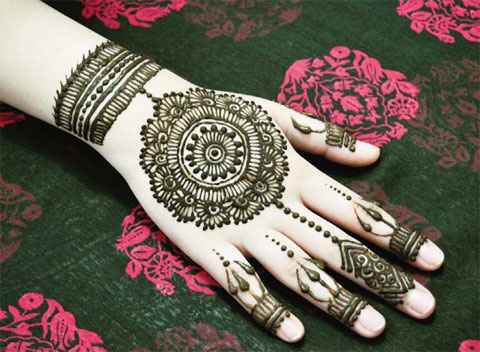 The young girl skillfully applied gold henna on the hands of women during an event, her mother watching approvingly. Only 17, her young age wasn't a barrier that prevented her from socializing and making conversation with her customers. Meet Samia Hasanat, a henna artist who has mastered her art after years of practice. Samia, originally from Bangladesh and born in Dubai, came with her family to Kuwait around eight years ago.
The young girl skillfully applied gold henna on the hands of women during an event, her mother watching approvingly. Only 17, her young age wasn't a barrier that prevented her from socializing and making conversation with her customers. Meet Samia Hasanat, a henna artist who has mastered her art after years of practice. Samia, originally from Bangladesh and born in Dubai, came with her family to Kuwait around eight years ago.
Samia has a deep love for henna, or mehndi as its known in the Indian Subcontinent, and has fond childhood memories of her aunt who used to apply it on her hands. "I blend my own henna from natural ingredients. I don't use readymade cones," she told Kuwait Times. Mehndi has been mentioned in ancient Indian texts and has been used by women, and sometimes, men. Despite arguments over the origin of this tradition, it is clear that it has been adopted mainly by countries of the Subcontinent such as India, Pakistan, Bangladesh and Sri Lanka.
"The difference between my work and that of other henna artists in Kuwait is in the pattern. Most designers base their work on Emirati designs of roses and swirls, while mine are more intricate. I combine peacocks, miniature flowers and other patterns inspired from Indian nature," said Samia.
Beginnings
It all began at the age of 13 when her father took her to a salon in Kuwait for a henna application before Eid. "The salon was busy and I had to wait for three hours. After all the wait, they told me to come tomorrow. I felt very bad. I decided then that I was going to learn this art and I would do it," she said. For four years, Samia trained using pen and paper and drawing on her own hand. "In the beginning, I practiced using readymade patterns. Later, I developed my own designs," she said.
News of her skill spread widely among her relatives and friends, who came to her to apply henna during religious ceremonies and marriages. "It was at first all for free, until an old family friend suggested that I should get paid for it," Samia said. Like any other home-based business in Kuwait, Samia thought of taking advantage of Instagram's popularity and created an account to showcase her artwork. She was captivated by the work of another henna artist, Amrin Wahid, who's based in Dubai.
"My home business took off only a year ago. My mother was worried I would lose interest in my studies since I'm making money now," said Samia. "But it is very surprising how my business is prompting me to study harder. I don't feel bored doing it - It's energizing and it makes me happier because I don't view it as a business. I just do it out of love as I'm passionate about henna art. I meet more people and gain more friends, so it doesn't negatively affect me as an A-level commerce student," she added.
Ambitions
"So far, this is merely the first step. But, I'm confident enough to state that I'm successful at this stage. As my next step, I'm going to start accepting international orders. My clients are interested in my customized art for brides, engagement parties, bridal showers and bespoke mobile phone cases. However, depending on Instagram to market my business is just a preliminary move to extend and open my own henna studio," Samia explained.
She believes, as an entrepreneur, that it's all about determination and solid motivation to make the thing most important to you a priority in your life. "Many get carried away during their teenage years, forgetting the fact that it is we who control ourselves by choosing good friends. Also, parents play a big role in this. They inspire you, support you and teach the difference between right and wrong. I guess it's entirely because of my parents that I'm on the right path,"Samia said.
"Remember, patience is a major principle since nothing happens quickly. You do not get what you want right away. You need to think about the steps and process them. I was naughty during my childhood though. I used to love ketchup.Once my mother gave me some and I spread it all over my body like a lotion!" she recalled. This incident somehow foretold that an artist was in the making.
By Athoob A Alshuaibi










